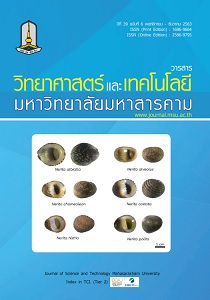Lineaments Extraction from Satellite Images in Chiang Mai, Chiang Rai, Phayao, and Lampang Province
Main Article Content
Abstract
Lineament is one of earth’s surface characteristic which correlated to the surface area such as ridges, rivers or faults which can be sometimes identified to geological structure. Currently, lineament surveying needs field survey data collection which can be time consuming. The objective of the study was to develop semi-automate procedure for extracting lineament form Landsat 8 OLI in some parts of Chiang Rai, Chiang Mai, Phayao, and Lampang provinces. There were 2 steps including 1) satellite data preparation which were used 4 methods containing Sobel Filter, Directional Filter, Laplacian Filter, and Principal Component Analysis (PCA), and 2) lineament extraction from the previous step and lineament transformation using Canny Edge Detection Algorithm. The result indicated that the direction of extracted lineament mostly lied in northeast-southwest direction and extracted lineament from PCA method was the most compatible with earth feature about 24.17%. The Sobel Filter, Directional Filter, and Laplacian Filter methods were compatible with earth feature about 19.30%, 5.13%, and 1.82% respectively.
Article Details
References
2 Sukumar, M., Venkatesan, N., and Nelson Kennedy Babu, C. 2014. A Review of Various Lineament Detection Techniques for high resolution Satellite Images. International Journal of Advanced Research in Computer Science and Software Engineering. Volume 4. Issue 3. pp. 72-78.
3 Xu, S. R., Li, C. C., and Flint, N. K., 1981.Extraction of Geological Lineaments from LANDSAT Imagery by Using Local Variance and Gradient Trend. LARS Symposia. 1981. Paper 415.
4 Mah, A., Lennox, P., Taylor, G., and Balia, L. 1995. Lineament analysis of Landsat thematic mapper images, Northern Territory, Australia. Photogrammetric Engineering & Remote Sensing. Vol. 61. No. 6. June 1995. pp. 761-773.
5 Karnieli, A., Meisels, A., Fisher, L., and Arkin, Y.1996. Automatic extraction and evaluation of geological linear features from digital remote sensing data using a hough transform. American Society for Photogrammetry and Remote Sensing, Bethesda. 62. MD, USA.
6 Süzen, M.L., and Toprak, V. 1998. Filtering of satellite images in geological lineament analyses: an application to a fault zone in Central Turkey. int. j. remote sensing. 1998. vol. 19. No. 6. 1101-1114.
7 Leech, D.P., Treloar, P.J., Lucas, N.S., and Grocott, J. 2003. Landsat TM analysis of fracture patterns: a case study from the Coastal Cordillera of northern Chile. International Journal of Remote Sensing, vol. 24, No. 19, 3709–3726.
8 Gannouni, S. and Gabtni, H. (2015) Structural Interpretation of Lineaments by Satellite Image Processing (Landsat TM) in the Region of Zahret Medien (Northern Tunisia). Journal of Geographic Information System, 7, 119-127.
9 ปัญญา จารุศิริ, วิโรจน์ ดาวฤกษ์, สุวิทย์ โคสุวรรณ, บุรินทร์ เวชบันเทิง, สุทธิพันธ์ ชุทรานนท์. 2543 . แผ่นดินไหวในประเทศไทย และพื้นแผ่นดินเอเชียตะวันออกเฉียงใต้. กรุงเทพฯ: สำนักงานกองทุนสนับสนุนการวิจัย(สกว.).
10 Ali, S A. and Pirasteh, S. 2004. Geological applications of Landsat enhanced thematic mapper (ETM) data and geographic information system (GIS): mapping and structural interpretation in south-west Iran, Zagros structural belt. International Journal of Remote Sensing, 25: 4715-4727.
11 Canny, J. 1986. A Computational Approach to Edge Detection. IEEE Transactions on Pattern Analysis and Machine Intelligence. Vol. PAMI-8, No. 6.


